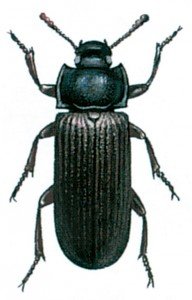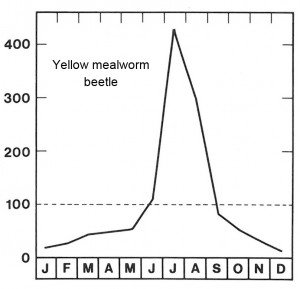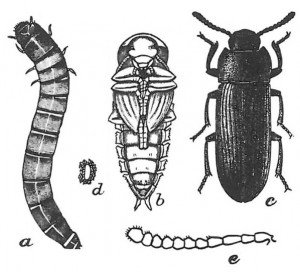

Latin: Tenebrio molitor.
Its larvae are probably best known as those mealworms that are sold as animal feed. It is a rather large beetle, 1.5 cm long. The yellow mealworm beetle lives in birds’ nests, where the larvae feed on the food spills that accumulate in the nests when the young birds are fed. The larvae can also live on all sorts of products containing starch, and they eat cereals, flour, grains and bread products whenever the opportunity presents itself. They are typically found in grains that have not been moved for some time, for example at the bottom of grain pits or silos. The development from egg to fully grown beetle lasts 6 – 12 months depending on both temperature and food. The development is most rapid at 26 ° C. Most yellow mealworm beetles overwinter as larvae and transform into beetles in the summer, where you can see them fly around in the summer months. The yellow mealworm beetles can fly through open windows and they rarely live in flour, grains and the like in regular households. The adult beetles and larvae are easy to find in flour when you sieve it through a kitchen sieve, but the eggs are whitish, sticky and almost invisible because of the flour particles, which stick to them. At 26 ° C, the eggs hatch in a month. Both beetles and larvae can travel long distances in houses and warehouses, especially when in the larval stages because they seek a sheltered place for pupation. These insects might jostle their way through pipe ducts and vents.

The yellow mealworms beetle is not a significant pest compared to years ago when it was common in grain storages and small mills. Today it often lives in sparrows’ nests. If you are bothered by yellow mealworm beetles in a building, you should detect and remove any birds’ nests. The surroundings should be treated with an insecticide powder because larvae, pupae or beetles hide in cracks and crevices near the nests. In cases where the larvae are found in a kitchen cabinet, it will usually be sufficient simply to discard the infested items.




